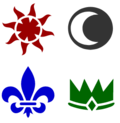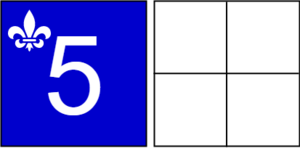| Game facts | |
|---|---|
| players | 2 |
| time | 20-30minutes |
| designers | Marty Hale-Evans, Ron Hale-Evans |
| license | CC BY-SA |
| source | ludism.org/… |
This is an old revision of the document!
Table of Contents
What is a piecepack?
A piecepack is a game system. A game system is a set of pieces with which you can play not just one but many games. The most popular game system is a deck of playing cards.
The piecepack is to board games what a deck of playing cards is to card games. Like a deck of playing cards, it is also in the Public Domain. That means you can do anything with it, including inventing new games and selling your own. That is why there are a lot of variations.
James Kyle invented the piecepack in 2001.

The standard
A standard piecepack consists of 24 tiles, 24 coins, 4 dice and 4 pawns. The pieces have 4 suits and 6 ranks.
Suits

The suits are:
- red suns
- black moons
- green or yellow crowns
- blue arms (represented by the fleur-de-lis)
Ranks

The ranks are:
- null (represented by an empty space)
- ace (represented by the suit, except on the coins it is represented by a spiral)
- 2
- 3
- 4
- 5
Pieces
There are 4 different types of pieces.
Square tiles

- 1 tile per suit/rank pair = 24 tiles
- faces have the rank in the center and the suit in the top left corner in their respective suit colour (“face up”)
- backs have a cross that forms a 2×2 grid (“grid-side up”)
The standard does not define any sizes. But most piecepack tiles are 2×2 inches (about 50×50 millimetres).
Round coins

- 1 coin per suit/rank pair = 24 coins
- faces have the rank in the same colour across all suits (“rank-side up”)
- backs have the suit in its colour (“suit-side up”)
- both sides have a marker to show direction (a dot or a line or a triangle, for example)
- a coin's width is at least half a tile's width or less, so that 4 coins fit on a tile
Six-sided dice

- 1 die per suit = 4 dice
- faces have all ranks in the suit's colour
Pawns

- 1 pawn per suit = 4 pawns
- in the colour of the suit
- they can have any shape
Variations
Your piecepack might not look like the description above. That's because a lot of piecepacks deviate from the standard. Here are some examples how your piecepack might be different. This usually does not affect gameplay.
- Some sets use completely different suits. Using French playing card suits (diamonds, hearts, spades and clubs) is quite common. Others use suits which represent the four seasons or four elements.
- Some sets don't use the fleur-de-lis for arms but an anchor, a shield or flowers.
- Some sets use a different symbol for the ace: An “A” (like for playing cards), a “1” or a spiral also on the tiles.
- Some sets use something for the null rank: A “0” or an “n”.
- Some sets add another suit or another rank.
- Some sets use different colours. Some use inverse colours.
- Some sets use monochrome colours, especially when they are made of wood.
- Some sets don't put the rank on the tiles in the center but to the side or into a corner. Some put the suit into two or even four corners or into the center. Some of those mark the top left corner as special in some way. Some put both rank and suit into the center on top of each other.
- Some make the back of the tiles checkered.
- Some use the suit's colour on the rank side of the coins. This would make some games unplayable as the suit needs to stay hidden.
- Some add the suit to the pawns and every die face. That makes them easier to use in low lighting conditions or for colourblind people.
- Some have pawns that have a direction, either by their shape or by having a marker.
People have also come up with various expansions and accessories to the piecepack.
